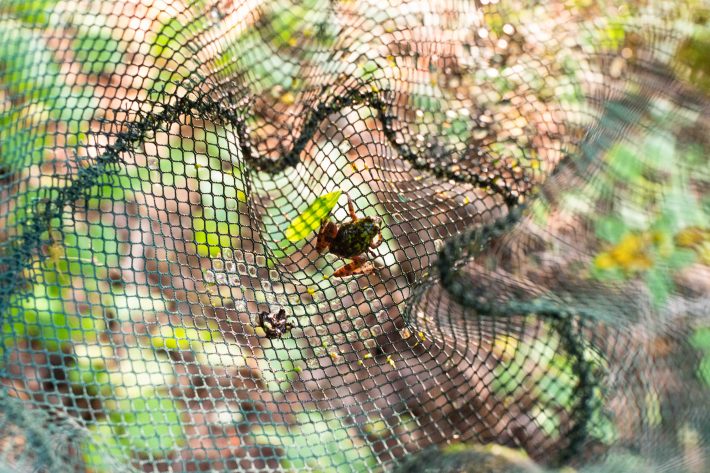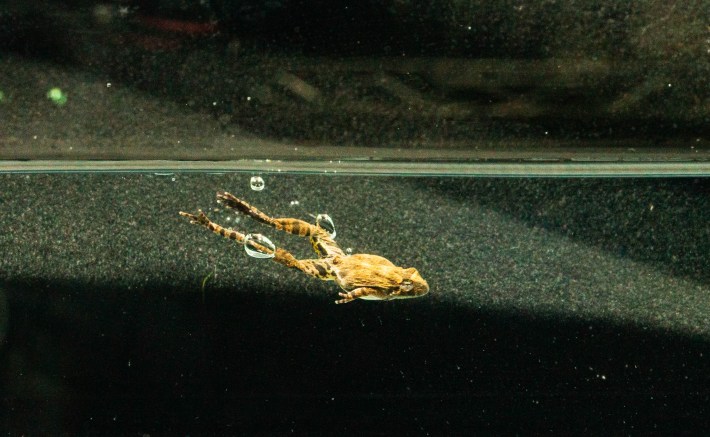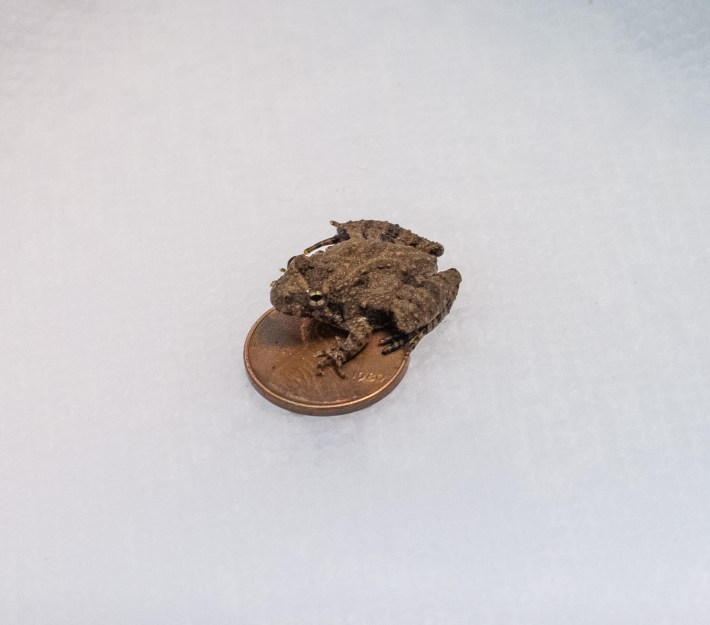If you are light enough, the water's surface is just another place to stretch your legs. The animal kingdom abounds with water-walkers: water striders perch atop ponds with thin legs held aloft with the help of water-repelling hair; basilisk lizards can run as far as five feet across water with long toes creating buoyant pockets of air; birds called western grebes have a mating ritual that involves running for up to seven seconds across water as their wide, flat feet slap the surface. And cricket frogs were long observed to cross ponds by way of "skittering," meaning jumping across the water without sinking.
Intrigued by the frogs' water-walking prowess, a group of scientists decided to study how the amphibians managed to stay at the top of the water's surface as they skittered, findings they recently reported in a paper in the Journal of Experimental Biology. When they filmed the cricket frogs on high-speed video, the researchers learned the hard truth behind skittering. Instead of bounding across the surface like a real water-walker, the cricket frogs completely submerged themselves in water between each hop. "This study is a testament to how even processes that seem so obvious can have a lot going on underneath the surface," Jasmine Nirody, a biophysicist at the University of Chicago who was not involved with the new paper, wrote in an email.
Nirody grew up watching frogs skittering across the water, and she had come across a few papers describing the locomotion, some dating back to the 1970s. But the footage from the new paper surprised her. "I never would have guessed this is what this form of locomotion looked like," she said.
Talia Weiss, an engineer and biomechanist, worked on the paper when she was a PhD student at Virginia Tech. Her advisor was working on a grant concerning animals that interact with the juncture between air and water, such as the basilisk lizard. Then Weiss read about skittering. "Learning about another water-walker that I had never heard of before was enough of a hook for me to start researching," she wrote in an email. Weiss scoured the literature to learn which frogs were known to skitter, and one species stood out: Northern cricket frogs, which lived close by. According to Weiss's research, the first researcher to explicitly define skittering was the zoologist Carl Gans, in a 1976 paper. But other researchers had noted the behavior before, sometimes calling it skipping or leaping across the water.
Before the researchers could study skittering, they needed to find some frogs. "Collecting the frogs was an adventure," Weiss said. The researchers searched for Northern cricket frogs, which can grow up to an inch long, at the edges of a state pond in North Carolina. But after nightfall, the biologist Jon Micancin, who studies cricket frog populations, led the crew to a special spot in the lake. "There were hundreds of these frogs swimming, jumping, and calling," Weiss said. Micancin helped the researchers collect 15 male Northern cricket frogs, returning all females to protect the breeding population, as well as any Southern cricket frogs. On average, each frog weighed half as much as a penny.


Back in the lab, the researchers needed to figure out how to make the frog boys skitter. They placed styrofoam pads and lily pads at the ends of the tank for the frogs to rest on, and ideally aim for. Then the researchers would encourage the frog to jump (read: gently poke with a finger). But the amphibians did not always cooperate. "The frogs often just swam away under the water surface," Weiss said. The researchers wanted to film their skittering straight-on in the center of the tank, but sometimes the frogs would jump in different directions, even colliding with the walls of the tank.
As such, "running these experiments required catching and repositioning the frogs several times, which was probably quite annoying for them," Weiss said. And some more recalcitrant frogs had other tricks up their sleeve. After they had their fill of skittering, they would swim to the bottom of the tank or even stop moving entirely. "The frogs were probably feigning death just to get me to leave them alone," Weiss said. When she later consulted the literature, she was reassured that the frogs play dead in the wild, too.
The researchers used high-speed cameras that captured up to 500 frames per second. When they slowed down the footage, they discovered that the frogs were not skipping across the water like a stone. "I was originally disappointed," Weiss said. But then she realized the frogs' locomotion had never been described before, making the discovery exciting in a new way.

Glenna Clifton, a comparative biomechanist at the University of Portland who was not involved with the new paper, found the cricket frogs' ability to totally submerge themselves in water between each jump "both surprising and impressive." Although the frog's leap out of the water appeared graceful, the return to the surface more closely resembled a belly flop.
Each frog's jump cycled through four stages in less than a second: a submerged takeoff, aerial time from a jump, reentry into the water, and a recovery for the next jump. The researchers decided to rename this locomotion "porpoising," after the way a porpoise or dolphin swims fast, leaps out of the water, splashes down, and then accelerates again for another leap. But unlike porpoises, the cricket frogs come to a stop after each leap and are unable to harness energy from their last jump. The researchers hypothesize the frogs are too slow to move their legs into position in time to jump from the surface of the water. This is just one of the reasons that a frog's interpretation of porpoising is less elegant than a dolphin's.
Clifton found the analogy to porpoising "somewhat appropriate" with a few key differences, such as the frog's inability to power their leaps with the momentum of their last jump. The frogs' shape and size limit them from using this momentum the way a sleek, aerodynamic animal like a dolphin could. Instead, the frogs "start from stillness and must generate the required force within a single propulsive foot paddle," Clifton wrote in an email. "In some ways this might be similar to squid jet propulsion out of the water."

Clifton found the paper to be a "good first investigation" into the differences between how cricket frogs hop on water and on land. She said she was less convinced of the authors' findings that the frogs could achieve similar jump heights from water and land, as the frogs' land-hopping behavior was much more erratic. Clifton hopes this study inspires more investigations with larger datasets.
But even if cricket frogs can't stay entirely out of the water in the true definition of skittering, and even if they don't look particularly graceful in what they do, their method of locomotion seems to suit them fine. "The fact that several species of frogs are using it means that it's good (enough) for certain purposes," Nirody said. Basilisks are able to stay atop the water's surface because they generate a lot of force, and geckos can run across the water thanks to adaptations like superhydrophobic belly skin, she added. "The frogs are doing the best they can within the constraints of their size and morphology," Nirody said.

In fact, the cricket frogs offer a wonderful example of what animals can achieve under specific constraints. This could be helpful in influencing bio-inspired design, Nirody said. "For instance, if we need a robot that's smaller/less powerful than a basilisk and can't utilize a superhydrophobic coating like geckos, then perhaps we can look to what these frogs are doing for some ideas," she added.
Besides the cricket frog is just one of a dozen frog species that have been described skittering. And until those species star in their own high-speed videos, the researchers can't rule out the possibility of a true skittering frog. In fact, Weiss and her colleagues are currently working on another paper that might answer the question. "We do think that it is possible for a frog to truly skitter," she said—no shade to the cricket frog, of course.







